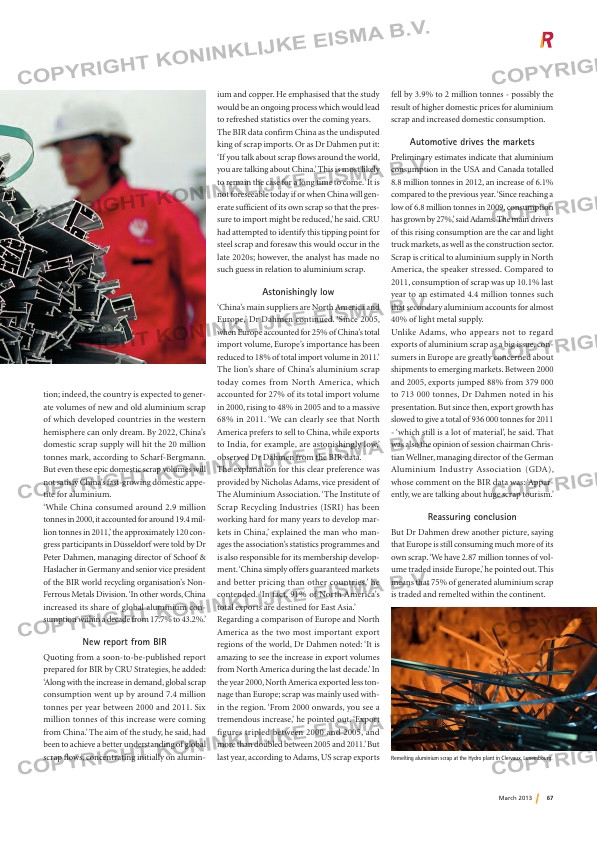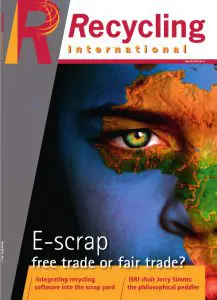Page 67 from: March 2013

67March 2013
tion; indeed, the country is expected to gener-
ate volumes of new and old aluminium scrap
of which developed countries in the western
hemisphere can only dream. By 2022, China’s
domestic scrap supply will hit the 20 million
tonnes mark, according to Scharf-Bergmann.
But even these epic domestic scrap volumes will
not satisfy China’s fast-growing domestic appe-
tite for aluminium.
‘While China consumed around 2.9 million
tonnes in 2000, it accounted for around 19.4 mil-
lion tonnes in 2011,’ the approximately 120 con-
gress participants in Düsseldorf were told by Dr
Peter Dahmen, managing director of Schoof &
Haslacher in Germany and senior vice president
of the BIR world recycling organisation’s Non-
Ferrous Metals Division. ‘In other words, China
increased its share of global aluminium con-
sumption within a decade from 17.7% to 43.2%.’
New report from BIR
Quoting from a soon-to-be-published report
prepared for BIR by CRU Strategies, he added:
‘Along with the increase in demand, global scrap
consumption went up by around 7.4 million
tonnes per year between 2000 and 2011. Six
million tonnes of this increase were coming
from China.’ The aim of the study, he said, had
been to achieve a better understanding of global
scrap flows, concentrating initially on alumin-
ium and copper. He emphasised that the study
would be an ongoing process which would lead
to refreshed statistics over the coming years.
The BIR data confirm China as the undisputed
king of scrap imports. Or as Dr Dahmen put it:
‘If you talk about scrap flows around the world,
you are talking about China.’ This is most likely
to remain the case for a long time to come. ‘It is
not foreseeable today if or when China will gen-
erate sufficient of its own scrap so that the pres-
sure to import might be reduced,’ he said. CRU
had attempted to identify this tipping point for
steel scrap and foresaw this would occur in the
late 2020s; however, the analyst has made no
such guess in relation to aluminium scrap.
Astonishingly low
‘China’s main suppliers are North America and
Europe,’ Dr Dahmen continued. ‘Since 2005,
when Europe accounted for 25% of China’s total
import volume, Europe’s importance has been
reduced to 18% of total import volume in 2011.’
The lion’s share of China’s aluminium scrap
today comes from North America, which
accounted for 27% of its total import volume
in 2000, rising to 48% in 2005 and to a massive
68% in 2011. ‘We can clearly see that North
America prefers to sell to China, while exports
to India, for example, are astonishingly low,’
observed Dr Dahmen from the BIR data.
The explanation for this clear preference was
provided by Nicholas Adams, vice president of
The Aluminium Association. ‘The Institute of
Scrap Recycling Industries (ISRI) has been
working hard for many years to develop mar-
kets in China,’ explained the man who man-
ages the association’s statistics programmes and
is also responsible for its membership develop-
ment. ‘China simply offers guaranteed markets
and better pricing than other countries,’ he
contended. ‘In fact, 91% of North America’s
total exports are destined for East Asia.’
Regarding a comparison of Europe and North
America as the two most important export
regions of the world, Dr Dahmen noted: ‘It is
amazing to see the increase in export volumes
from North America during the last decade.’ In
the year 2000, North America exported less ton-
nage than Europe; scrap was mainly used with-
in the region. ‘From 2000 onwards, you see a
tremendous increase,’ he pointed out. ‘Export
figures tripled between 2000 and 2005, and
more than doubled between 2005 and 2011.’ But
last year, according to Adams, US scrap exports
fell by 3.9% to 2 million tonnes – possibly the
result of higher domestic prices for aluminium
scrap and increased domestic consumption.
Automotive drives the markets
Preliminary estimates indicate that aluminium
consumption in the USA and Canada totalled
8.8 million tonnes in 2012, an increase of 6.1%
compared to the previous year. ‘Since reaching a
low of 6.8 million tonnes in 2009, consumption
has grown by 27%,’ said Adams. The main drivers
of this rising consumption are the car and light
truck markets, as well as the construction sector.
Scrap is critical to aluminium supply in North
America, the speaker stressed. Compared to
2011, consumption of scrap was up 10.1% last
year to an estimated 4.4 million tonnes such
that secondary aluminium accounts for almost
40% of light metal supply.
Unlike Adams, who appears not to regard
exports of aluminium scrap as a big issue, con-
sumers in Europe are greatly concerned about
shipments to emerging markets. Between 2000
and 2005, exports jumped 88% from 379 000
to 713 000 tonnes, Dr Dahmen noted in his
presentation. But since then, export growth has
slowed to give a total of 936 000 tonnes for 2011
– ‘which still is a lot of material’, he said. That
was also the opinion of session chairman Chris-
tian Wellner, managing director of the German
Aluminium Industry Association (GDA),
whose comment on the BIR data was: ‘Appar-
ently, we are talking about huge scrap tourism.’
Reassuring conclusion
But Dr Dahmen drew another picture, saying
that Europe is still consuming much more of its
own scrap. ‘We have 2.87 million tonnes of vol-
ume traded inside Europe,’ he pointed out. This
means that 75% of generated aluminium scrap
is traded and remelted within the continent.
Remelting aluminium scrap at the Hydro plant in Clervaux, Luxembourg.
RI_2-AluRIindd.indd 67 06-03-13 11:59



